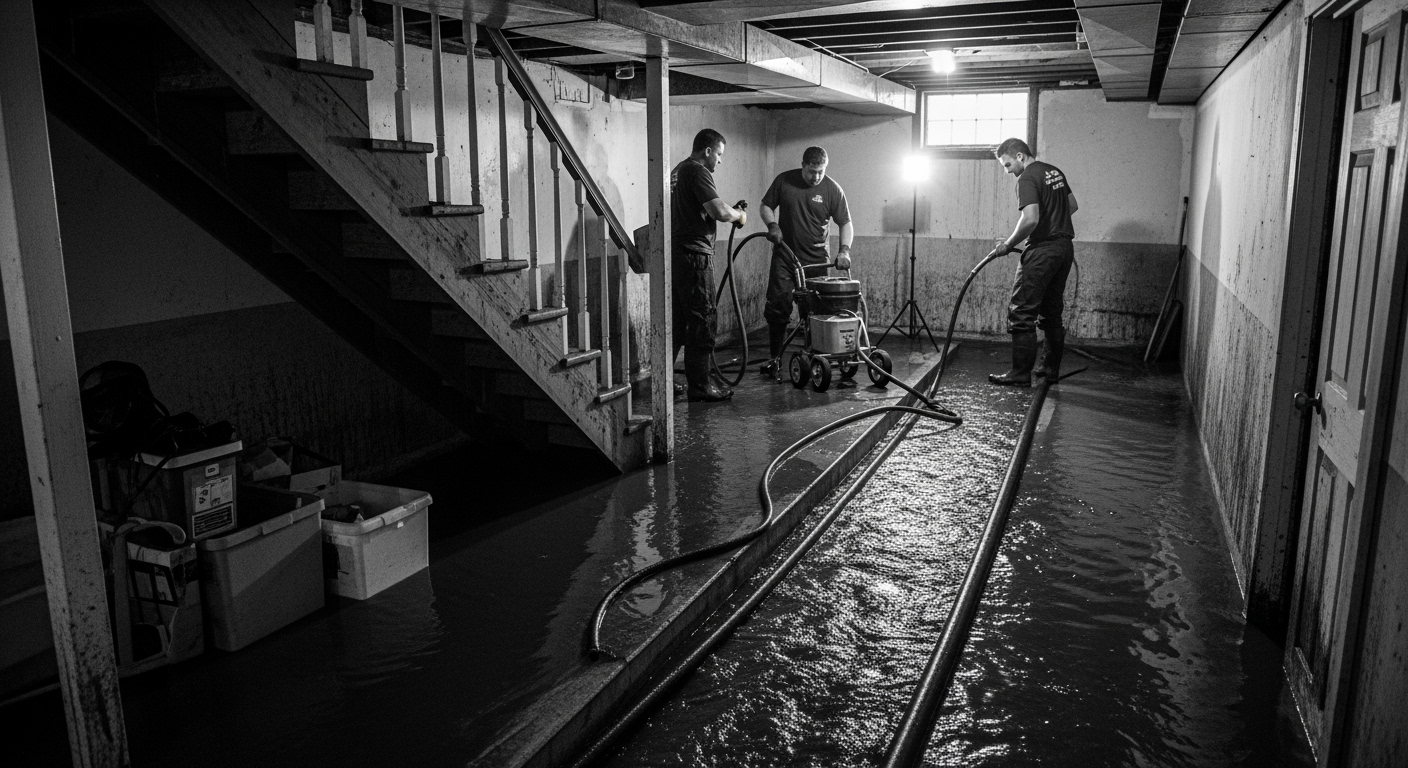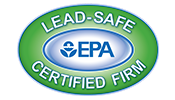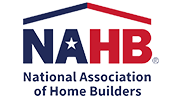Understanding Basement Sewage Backup Causes
Basement sewage cleanup becomes necessary when various failures send contaminated water into your home’s lowest level. Initially, municipal sewer line blockages cause widespread neighborhood backups during heavy rains. Furthermore, tree roots infiltrating sewer lines create blockages that force sewage backward. Additionally, basement sewage cleanup often follows sump pump failures during storms. Meanwhile, broken sewer pipes beneath foundations leak continuously. Therefore, understanding causes helps prevent future basement sewage cleanup needs.
Multiple factors make basements particularly vulnerable to sewage problems. First, basements sit below sewer line levels, creating reverse flow risks. Then, floor drains provide direct pathways for backup entry. Moreover, hydrostatic pressure forces contaminated groundwater through cracks. Subsequently, aging infrastructure increases failure likelihood significantly. Consequently, basement sewage cleanup addresses problems unique to below-grade spaces.
Common Sewage Entry Points
Basement sewage cleanup must address multiple contamination entry points. Initially, floor drains serve as primary backup locations. Additionally, toilet and shower drains in basement bathrooms overflow.
- Sump pump pits overflowing with contaminated water
- Foundation cracks allowing sewage infiltration
- Window wells filling with contaminated runoff
- Utility penetrations leaking sewage
- Laundry drain backups from main line
- Ejector pump failures causing overflow
Therefore, comprehensive basement sewage cleanup addresses all entry points. Moreover, prevention requires monitoring these vulnerable areas.
Immediate Health Hazards Requiring Emergency Response
Deadly Pathogens in Sewage Water
Basement sewage cleanup addresses Category 3 “black water” containing life-threatening contaminants. First, E. coli bacteria causes severe gastrointestinal illness. Additionally, Hepatitis A virus spreads through contaminated water contact. Furthermore, parasites like Giardia and Cryptosporidium survive in sewage. Meanwhile, Salmonella and Shigella bacteria cause serious infections. Therefore, basement sewage cleanup requires extreme caution and professional handling.
Disease transmission occurs through multiple pathways. Initially, direct skin contact with sewage causes infections. Then, airborne particles from disturbed sewage enter respiratory systems. Moreover, contaminated surfaces spread pathogens through touch. Subsequently, pets tracking through sewage spread contamination. Finally, inadequate cleanup leaves dangerous residues behind.
Toxic Gases and Air Quality Dangers
Basement sewage cleanup must address dangerous gases beyond visible contamination. Initially, hydrogen sulfide gas causes headaches and respiratory issues. Additionally, methane accumulation creates explosion risks.
- Ammonia fumes irritating respiratory systems
- Carbon dioxide displacing oxygen
- Volatile organic compounds causing illness
- Endotoxins triggering allergic reactions
- Bioaerosols spreading disease particles
- Chemical vapors from household products
Consequently, basement sewage cleanup requires continuous air monitoring. Furthermore, proper ventilation protects workers and residents.
Emergency Response Protocol for Basement Sewage
First 60 Minutes Critical Actions
Immediate basement sewage cleanup response prevents escalating health hazards and damage. First, evacuate all people and pets from contaminated areas immediately. Additionally, shut off electricity to affected basement areas safely. Furthermore, stop using all plumbing fixtures to prevent additional backup. Meanwhile, contact professional basement sewage cleanup services immediately. Therefore, quick action minimizes exposure and damage significantly.
Documentation begins during initial response. Initially, photograph sewage levels and affected areas. Then, list damaged items for insurance claims. Moreover, note the backup’s start time and suspected cause. Subsequently, gather insurance policy information readily. Finally, prepare questions for restoration professionals.
Safety Precautions Before Professional Arrival
While awaiting basement sewage cleanup professionals, safety remains paramount. Initially, never enter sewage-contaminated areas without protection. Additionally, keep children and pets completely away.
- Open windows above ground for ventilation
- Avoid using HVAC systems spreading contamination
- Don’t attempt DIY cleanup without proper gear
- Never use regular vacuums on sewage
- Avoid electrical equipment near water
- Don’t move contaminated items through house
Therefore, waiting for professional basement sewage cleanup protects health. Moreover, amateur attempts often worsen contamination spread.
Professional Basement Sewage Cleanup Process
Initial Assessment and Containment
Professional basement sewage cleanup begins with comprehensive safety assessment and containment. First, technicians evaluate structural integrity and electrical hazards. Additionally, air quality testing determines contamination levels. Furthermore, containment barriers prevent sewage spread to clean areas. Meanwhile, negative air pressure stops airborne particles from migrating. Therefore, proper containment during basement sewage cleanup protects the entire home.
Equipment setup follows specific protocols. Initially, HEPA air scrubbers begin filtering contaminated air. Then, plastic barriers seal stairways and openings. Moreover, decontamination stations get established at entry points. Subsequently, warning signs alert everyone to hazards. Finally, protective floor coverings create clean pathways.
Extraction and Waste Removal
Basement sewage cleanup requires powerful extraction equipment for standing water. Initially, submersible pumps remove deep sewage accumulations. Additionally, truck-mounted extractors provide powerful suction.
- Specialized sewage pumps handling solids
- Wet vacuums with containment features
- Proper filtration preventing re-contamination
- Segregated waste containers for disposal
- Manifested hazardous waste removal
- EPA-compliant disposal procedures
Consequently, professional basement sewage cleanup removes all contaminated water. Furthermore, proper disposal prevents environmental violations.
Decontamination and Sanitization Procedures
EPA-Registered Antimicrobial Application
Basement sewage cleanup requires hospital-grade disinfection killing all pathogens. First, EPA-registered antimicrobials eliminate bacteria, viruses, and parasites. Additionally, proper contact time ensures complete pathogen destruction. Furthermore, multiple applications address porous materials thoroughly. Meanwhile, fogging reaches inaccessible areas effectively. Therefore, professional basement sewage cleanup achieves medical-grade cleanliness.
Application methods vary by surface type. Initially, hard surfaces receive spray and wipe treatment. Then, porous materials get deep saturation treatment. Moreover, HVAC systems undergo internal disinfection. Subsequently, crawl spaces receive thorough treatment. Finally, verification testing confirms successful decontamination.
Specialized Cleaning Techniques
Different materials require specific basement sewage cleanup approaches. Initially, concrete floors need pressure washing with antimicrobials. Additionally, wooden structures require careful moisture management.
- Steam cleaning for appropriate surfaces
- Biohazard removal from personal items
- HEPA vacuuming after drying
- Enzyme treatments for organic matter
- Oxidizing agents eliminating odors
- Encapsulation for semi-porous materials
Therefore, varied techniques ensure thorough basement sewage cleanup. Moreover, proper methods prevent material damage. Our water damage cleanup services in Pennsylvania include sewage contamination expertise.
Structural Drying After Sewage Extraction
Preventing Mold Growth
Basement sewage cleanup must include aggressive drying preventing mold development. First, sewage provides ideal nutrients for rapid mold growth. Additionally, basement humidity levels encourage fungal proliferation. Furthermore, organic materials become mold food sources quickly. Meanwhile, hidden moisture enables extensive colonization. Therefore, thorough drying during basement sewage cleanup prevents secondary problems.
Scientific drying approaches ensure complete moisture removal. Initially, commercial dehumidifiers extract atmospheric moisture. Then, high-velocity air movers accelerate evaporation rates. Moreover, temperature control optimizes drying conditions. Subsequently, daily monitoring tracks moisture reduction. Finally, documented readings prove successful drying.
Specialized Basement Drying Challenges
Below-grade spaces present unique basement sewage cleanup drying challenges. Initially, limited ventilation slows moisture removal. Additionally, concrete retains moisture for extended periods.
- Foundation moisture requires specialized equipment
- Vapor barriers trap contaminated moisture
- Insulation holds sewage requiring removal
- Wooden structures need careful monitoring
- HVAC systems require complete drying
- Hidden cavities need injection drying
Consequently, basement sewage cleanup addresses unique drying requirements. Furthermore, inadequate drying causes ongoing problems.
Content Evaluation and Restoration
Salvageable vs. Non-Salvageable Items
Basement sewage cleanup includes difficult decisions about contaminated belongings. First, porous materials absorbing sewage require disposal typically. Additionally, items with sentimental value need careful evaluation. Furthermore, restoration costs might exceed replacement values. Meanwhile, health risks outweigh saving contaminated items. Therefore, professional basement sewage cleanup guides these challenging decisions.
Specific guidelines determine salvageability. Initially, non-porous items often clean successfully. Then, sealed items might escape contamination. Moreover, elevated items avoid direct contact. Subsequently, quick response improves restoration chances. Finally, professional cleaning restores many items.
Professional Content Cleaning Services
Specialized basement sewage cleanup includes content restoration when possible. Initially, ultrasonic cleaning removes contamination from hard goods. Additionally, specialized laundry processes clean textiles.
- Document freeze-drying and restoration
- Electronic cleaning and testing
- Furniture cleaning and refinishing
- Photograph restoration services
- Artwork conservation techniques
- Mattress disposal requirements
Therefore, professional basement sewage cleanup maximizes property recovery. Moreover, proper cleaning eliminates health risks.
Reconstruction and Repair Needs
Demolition of Contaminated Materials
Basement sewage cleanup often requires removing irreparably contaminated materials. First, saturated drywall must be cut above water lines. Additionally, contaminated insulation requires complete removal. Furthermore, carpet and padding exposed to sewage need disposal. Meanwhile, damaged flooring might require replacement. Therefore, demolition during basement sewage cleanup eliminates health hazards.
Safe demolition follows strict protocols. Initially, containment prevents contamination spread. Then, workers wear complete protective equipment. Moreover, materials get double-bagged immediately. Subsequently, proper disposal follows regulations. Finally, areas get disinfected after removal.
Rebuilding and Restoration
Following demolition, basement sewage cleanup transitions to reconstruction. Initially, antimicrobial treatments prepare surfaces. Additionally, moisture-resistant materials get selected.
- Mold-resistant drywall installation
- Antimicrobial paint application
- Waterproof flooring selection
- Improved drainage system installation
- Backflow preventer addition
- Sump pump upgrade or replacement
Consequently, reconstruction after basement sewage cleanup improves resilience. Furthermore, upgrades prevent future incidents.
Insurance Coverage for Sewage Backup
Understanding Policy Limitations
Basement sewage cleanup insurance coverage varies significantly between policies. First, standard homeowner’s insurance typically excludes sewage backup. Additionally, separate endorsements provide sewage coverage. Furthermore, coverage limits might prove inadequate for extensive damage. Meanwhile, deductibles apply to sewage claims specifically. Therefore, understanding coverage before basement sewage cleanup prevents surprises.
Documentation supports insurance claims effectively. Initially, professional assessment reports establish damage extent. Then, detailed photo documentation proves contamination levels. Moreover, itemized inventories list all losses. Subsequently, receipts verify mitigation expenses. Finally, professional estimates justify restoration costs.
Maximizing Insurance Recovery
Strategic approaches improve basement sewage cleanup insurance settlements. Initially, immediate mitigation prevents claim denial. Additionally, professional documentation carries more weight.
- Temporary living expense documentation
- Business property loss claims
- Additional coverage investigations
- Public adjuster consideration
- Depreciation recovery pursuit
- Code upgrade coverage utilization
Therefore, proper procedures maximize basement sewage cleanup coverage. Moreover, professional assistance navigates complex claims. Our fire and smoke damage restoration in New York includes insurance coordination.
Prevention Strategies for Future Protection
Backflow Prevention Systems
Installing prevention devices reduces basement sewage cleanup risks significantly. First, backflow valves prevent reverse flow automatically. Additionally, overhead sewers eliminate gravity backup risks. Furthermore, ejector pumps with alarms provide warnings. Meanwhile, regular maintenance ensures system functionality. Therefore, prevention investments protect against basement sewage cleanup needs.
Maintenance programs prevent system failures. Initially, annual professional inspections identify problems. Then, regular cleaning prevents blockages. Moreover, tree root treatments protect pipes. Subsequently, camera inspections reveal developing issues. Finally, prompt repairs prevent major failures.
Emergency Preparedness Planning
Preparation minimizes basement sewage cleanup impact when disasters occur. Initially, maintain restoration company contacts readily. Additionally, know water shutoff locations clearly.
- Create basement inventory documentation
- Store valuables above potential flood levels
- Install water sensors and alarms
- Review insurance coverage annually
- Maintain emergency supply kits
- Develop family evacuation plans
Consequently, preparation reduces basement sewage cleanup severity. Furthermore, quick response minimizes health risks.
Health Monitoring After Cleanup
Potential Health Effects
Even after professional basement sewage cleanup, health monitoring remains important. First, some infections develop days after exposure. Additionally, respiratory symptoms might appear gradually. Furthermore, skin infections require medical attention promptly. Meanwhile, gastrointestinal issues need evaluation. Therefore, post-cleanup health awareness protects families.
Specific symptoms warrant medical consultation. Initially, persistent coughing or breathing difficulties. Then, unexplained fevers or fatigue. Moreover, skin rashes or infections. Subsequently, ongoing digestive problems. Finally, unusual allergic reactions.
Indoor Air Quality Testing
Verification testing confirms successful basement sewage cleanup completion. Initially, bacterial testing ensures pathogen elimination. Additionally, mold spore counts verify prevention success.
- Volatile organic compound measurements
- Particulate matter assessment
- Humidity level monitoring
- Odor evaluation testing
- Surface ATP testing
- Clearance documentation
Therefore, testing validates basement sewage cleanup effectiveness. Moreover, documentation provides peace of mind.
Take Action: Professional Basement Sewage Cleanup Services
When sewage floods your basement, every minute counts in protecting your family’s health and property. Advanced Disaster Recovery Inc. provides immediate basement sewage cleanup response with certified technicians equipped to handle these dangerous biohazard situations safely. Moreover, our comprehensive approach addresses extraction, decontamination, drying, and reconstruction while managing insurance claims. We understand the unique challenges of basement sewage cleanup and bring specialized equipment designed for below-grade restoration.
Don’t risk your family’s health with inadequate cleanup attempts. Contact Advanced Disaster Recovery Inc. immediately for professional basement sewage cleanup that eliminates all contamination and restores your basement completely. Additionally, our 24/7 emergency response means help arrives quickly when you need it most. Trust our expertise to guide you through this challenging situation with professional basement sewage cleanup that protects what matters most.
Emergency Basement Sewage Cleanup Services
Biohazard Response for Flooded Basements
✓ 24/7 emergency response
✓ Complete biohazard decontamination
✓ Structural drying and restoration
✓ Insurance claim assistance
✓ Prevention system installation









